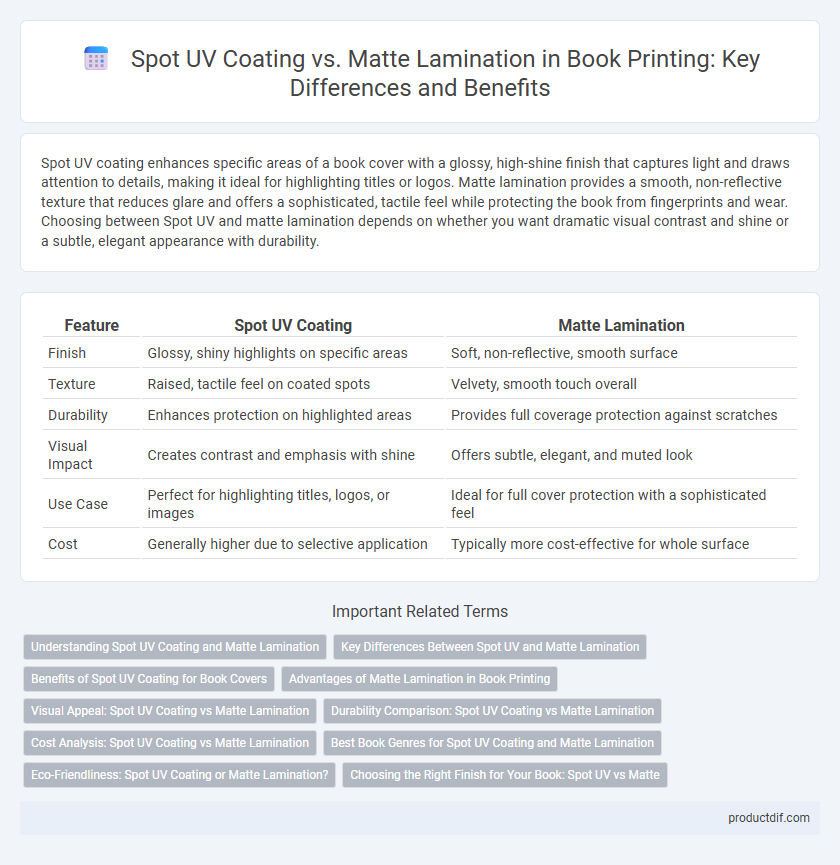Spot UV coating enhances specific areas of a book cover with a glossy, high-shine finish that captures light and draws attention to details, making it ideal for highlighting titles or logos. Matte lamination provides a smooth, non-reflective texture that reduces glare and offers a sophisticated, tactile feel while protecting the book from fingerprints and wear. Choosing between Spot UV and matte lamination depends on whether you want dramatic visual contrast and shine or a subtle, elegant appearance with durability.
Table of Comparison
| Feature | Spot UV Coating | Matte Lamination |
|---|---|---|
| Finish | Glossy, shiny highlights on specific areas | Soft, non-reflective, smooth surface |
| Texture | Raised, tactile feel on coated spots | Velvety, smooth touch overall |
| Durability | Enhances protection on highlighted areas | Provides full coverage protection against scratches |
| Visual Impact | Creates contrast and emphasis with shine | Offers subtle, elegant, and muted look |
| Use Case | Perfect for highlighting titles, logos, or images | Ideal for full cover protection with a sophisticated feel |
| Cost | Generally higher due to selective application | Typically more cost-effective for whole surface |
Understanding Spot UV Coating and Matte Lamination
Spot UV coating is a printing technique applying a glossy, raised layer selectively on specific parts of a book cover, enhancing visual appeal and tactile contrast. Matte lamination involves applying a thin, non-glossy film over the entire cover surface, providing a smooth, muted finish that reduces glare and increases durability. Both methods serve to protect printed materials while offering distinct aesthetic and tactile experiences tailored to different design preferences.
Key Differences Between Spot UV and Matte Lamination
Spot UV Coating highlights specific areas of a book cover with a glossy, raised finish, creating a striking contrast against the matte or uncoated background. Matte Lamination, in contrast, provides an overall smooth, non-reflective surface that reduces glare and enhances durability while maintaining a subtle, elegant appearance. Key differences include Spot UV's selective shine and tactile texture versus Matte Lamination's consistent, soft finish and enhanced protection.
Benefits of Spot UV Coating for Book Covers
Spot UV coating enhances book covers by creating a high-gloss, reflective finish that highlights specific design elements, increasing visual appeal and attracting reader attention. This technique provides tactile contrast, making titles or images stand out, which improves shelf presence and perceived value. Spot UV also offers durability by protecting targeted areas from scratches and wear, extending the book cover's lifespan while maintaining aesthetic quality.
Advantages of Matte Lamination in Book Printing
Matte lamination in book printing offers superior glare reduction and a smooth, elegant finish that enhances readability and provides a sophisticated tactile experience. It increases durability by protecting pages from fingerprints, scratches, and moisture, extending the book's lifespan. Matte lamination also improves color vibrancy subtly without the reflective shine, making it ideal for books with a classic or understated aesthetic.
Visual Appeal: Spot UV Coating vs Matte Lamination
Spot UV coating creates a striking contrast by applying a glossy finish selectively, enhancing specific areas such as titles or images for a vibrant, eye-catching effect. Matte lamination offers a smooth, non-reflective surface that delivers a sophisticated, understated look while reducing glare and fingerprints. Choosing between Spot UV and matte lamination depends on whether the goal is bold visual impact or elegant subtlety in book design.
Durability Comparison: Spot UV Coating vs Matte Lamination
Spot UV coating offers a glossy, raised finish that enhances specific areas of a book cover but is more prone to scratching and wear over time compared to matte lamination. Matte lamination provides a smooth, non-reflective surface that is highly resistant to fingerprints, scuffs, and general abrasion, resulting in superior durability for frequently handled books. For long-lasting protection, matte lamination outperforms spot UV coating by maintaining the integrity of the book cover under heavy use.
Cost Analysis: Spot UV Coating vs Matte Lamination
Spot UV coating generally incurs lower material costs compared to matte lamination, making it more budget-friendly for short print runs. Matte lamination involves higher expenses due to the additional lamination process and materials, but it offers enhanced durability and premium tactile appeal. For large print volumes, the cost per unit for matte lamination decreases, potentially narrowing the price gap with Spot UV coating.
Best Book Genres for Spot UV Coating and Matte Lamination
Spot UV coating excels in enhancing visual appeal for art books, photography collections, and luxury coffee table books by creating striking contrasts and glossy highlights that attract readers' attention. Matte lamination is ideal for literary fiction, memoirs, and poetry collections, offering a smooth, elegant finish that reduces glare and adds a tactile quality preferred in intimate reading experiences. Choosing between Spot UV and Matte lamination depends largely on the book genre's aesthetic requirements and reader interaction, with Spot UV highlighting key design elements and Matte lamination providing a sophisticated, understated look.
Eco-Friendliness: Spot UV Coating or Matte Lamination?
Matte lamination offers greater eco-friendliness compared to spot UV coating due to its biodegradable and recyclable materials, reducing environmental impact. Spot UV coating typically involves UV-curable varnishes that contain chemicals less friendly to ecosystems and are harder to recycle. Choosing matte lamination supports sustainability in book production while maintaining a refined, non-glossy finish.
Choosing the Right Finish for Your Book: Spot UV vs Matte
Spot UV coating creates a glossy, raised effect that highlights specific design elements on your book cover, adding a striking visual appeal and texture contrast. Matte lamination offers a smooth, non-reflective finish that reduces glare and provides a sophisticated, tactile experience while enhancing durability. Selecting between Spot UV and matte lamination depends on your book's aesthetic goals, target audience, and desired tactile impact for optimal presentation and protection.
Spot UV Coating vs Matte Lamination Infographic

 productdif.com
productdif.com